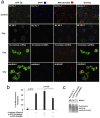Chymase mediates injury and mitochondrial damage in cardiomyocytes during acute ischemia/reperfusion in the dog
- PMID: 24733352
- PMCID: PMC3986229
- DOI: 10.1371/journal.pone.0094732
Chymase mediates injury and mitochondrial damage in cardiomyocytes during acute ischemia/reperfusion in the dog
Abstract
Cardiac ischemia and reperfusion (I/R) injury occurs because the acute increase in oxidative/inflammatory stress during reperfusion culminates in the death of cardiomyocytes. Currently, there is no drug utilized clinically that attenuates I/R injury in patients. Previous studies have demonstrated degranulation of mast cell contents into the interstitium after I/R. Using a dog model of I/R, we tested the role of chymase, a mast cell protease, in cardiomyocyte injury using a specific oral chymase inhibitor (CI). 15 adult mongrel dogs had left anterior descending artery occlusion for 60 min and reperfusion for 100 minutes. 9 dogs received vehicle and 6 were pretreated with a specific CI. In vivo cardiac microdialysis demonstrated a 3-fold increase in interstitial fluid chymase activity in I/R region that was significantly decreased by CI. CI pretreatment significantly attenuated loss of laminin, focal adhesion complex disruption, and release of troponin I into the circulation. Microarray analysis identified an I/R induced 17-fold increase in nuclear receptor subfamily 4A1 (NR4A1) and significantly decreased by CI. NR4A1 normally resides in the nucleus but can induce cell death on migration to the cytoplasm. I/R caused significant increase in NR4A1 protein expression and cytoplasmic translocation, and mitochondrial degradation, which were decreased by CI. Immunohistochemistry also revealed a high concentration of chymase within cardiomyocytes after I/R. In vitro, chymase added to culture HL-1 cardiomyocytes entered the cytoplasm and nucleus in a dynamin-dependent fashion, and promoted cytoplasmic translocation of NR4A1 protein. shRNA knockdown of NR4A1 on pre-treatment of HL-1 cells with CI significantly decreased chymase-induced cell death and mitochondrial damage. These results suggest that the beneficial effects of an orally active CI during I/R are mediated in the cardiac interstitium as well as within the cardiomyocyte due to a heretofore-unrecognized chymase entry into cardiomyocytes.
Conflict of interest statement
Figures









Similar articles
-
Dual inhibition of cathepsin G and chymase reduces myocyte death and improves cardiac remodeling after myocardial ischemia reperfusion injury.Basic Res Cardiol. 2017 Sep 14;112(6):62. doi: 10.1007/s00395-017-0652-z. Basic Res Cardiol. 2017. PMID: 28913553 Free PMC article.
-
Mast cell chymase limits the cardiac efficacy of Ang I-converting enzyme inhibitor therapy in rodents.J Clin Invest. 2010 Apr;120(4):1229-39. doi: 10.1172/JCI39345. Epub 2010 Mar 24. J Clin Invest. 2010. PMID: 20335663 Free PMC article.
-
NR4A1 Promotes Cerebral Ischemia Reperfusion Injury by Repressing Mfn2-Mediated Mitophagy and Inactivating the MAPK-ERK-CREB Signaling Pathway.Neurochem Res. 2018 Oct;43(10):1963-1977. doi: 10.1007/s11064-018-2618-4. Epub 2018 Aug 22. Neurochem Res. 2018. PMID: 30136162
-
Novel Insight into the in vivo Function of Mast Cell Chymase: Lessons from Knockouts and Inhibitors.J Innate Immun. 2020;12(5):357-372. doi: 10.1159/000506985. Epub 2020 Jun 4. J Innate Immun. 2020. PMID: 32498069 Free PMC article. Review.
-
Chymase inhibitors for the treatment of cardiac diseases: a patent review (2010-2018).Expert Opin Ther Pat. 2018 Nov;28(11):755-764. doi: 10.1080/13543776.2018.1531848. Epub 2018 Oct 10. Expert Opin Ther Pat. 2018. PMID: 30278800 Free PMC article. Review.
Cited by
-
Deficiency of mouse mast cell protease 4 mitigates cardiac dysfunctions in mice after myocardium infarction.Biochim Biophys Acta Mol Basis Dis. 2019 Jun 1;1865(6):1170-1181. doi: 10.1016/j.bbadis.2019.01.011. Epub 2019 Jan 11. Biochim Biophys Acta Mol Basis Dis. 2019. PMID: 30639224 Free PMC article.
-
Mast cell proteases as pharmacological targets.Eur J Pharmacol. 2016 May 5;778:44-55. doi: 10.1016/j.ejphar.2015.04.045. Epub 2015 May 7. Eur J Pharmacol. 2016. PMID: 25958181 Free PMC article. Review.
-
Chymase uptake by cardiomyocytes results in myosin degradation in cardiac volume overload.Heliyon. 2019 Apr 4;5(4):e01397. doi: 10.1016/j.heliyon.2019.e01397. eCollection 2019 Apr. Heliyon. 2019. PMID: 30997426 Free PMC article.
-
Multifunctional Role of Chymase in Acute and Chronic Tissue Injury and Remodeling.Circ Res. 2018 Jan 19;122(2):319-336. doi: 10.1161/CIRCRESAHA.117.310978. Circ Res. 2018. PMID: 29348253 Free PMC article. Review.
-
Degranulation of gastrointestinal mast cells contributes to hepatic ischemia-reperfusion injury in mice.Clin Sci (Lond). 2018 Oct 29;132(20):2241-2259. doi: 10.1042/CS20180662. Print 2018 Oct 31. Clin Sci (Lond). 2018. PMID: 30301760 Free PMC article.
References
-
- Yellon DM, Hausenloy DJ. Myocardial reperfusion injury (2007) N Engl J Med. 357: 1121–1135. - PubMed
-
- Frangogiannis NG, Perrard JL, Mendoza LH, Burns AR, Lindsey ML, et al. (1998) Stem cell factor induction is associated with mast cell accumulation after canine myocardial ischemia and reperfusion. Circulation 98: 687–698. - PubMed
-
- Caughey GH, Raymond WW, Wolters PJ (2000) Angiotensin II generation by mast cell alpha- and beta-chymases. Biochim Biophys Acta 1480: 245–257. - PubMed
-
- Vartio T, Seppa H, Vaheri A (1981) Susceptibility of soluble and matrix fibronectins to degradation by tissue proteinases, mast cell chymase and cathepsin G. J Biol Chem. 256: 471–477. - PubMed
Publication types
MeSH terms
Substances
Grants and funding
LinkOut - more resources
Full Text Sources
Other Literature Sources
Medical

